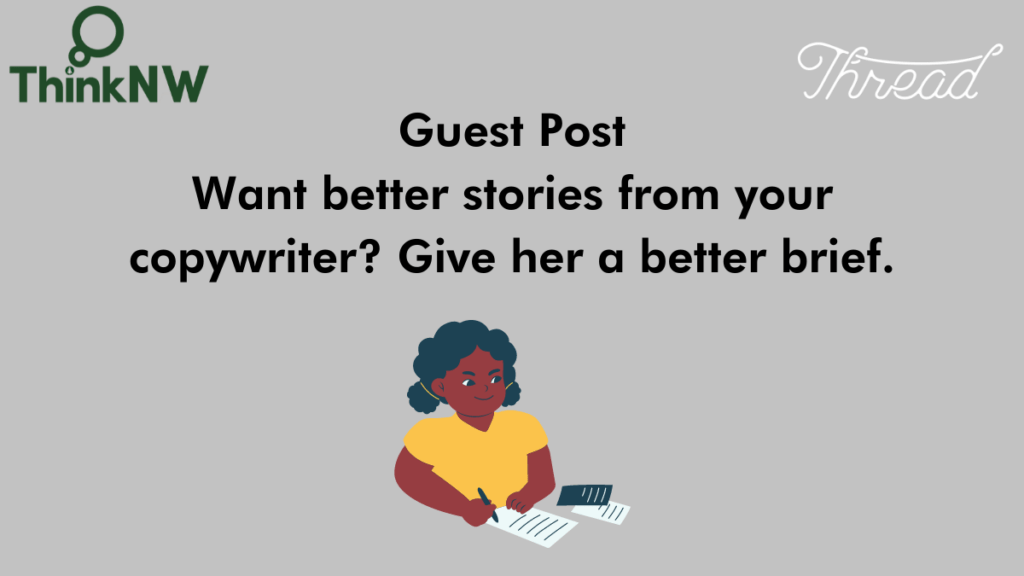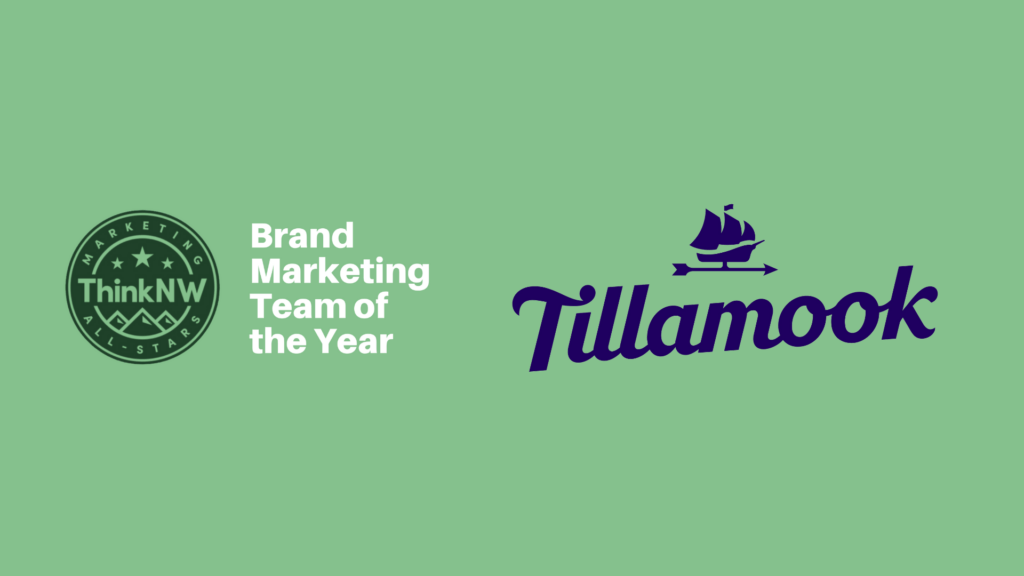Want Better Stories From Your Copywriter? Give Her a Better Brief

(Guest post from Thread’s Karen Ford. The original post can be found here.)
You did it – you made a strong business case to hire a professional writer or writing studio, and you now have that coveted line item in your content creation budget: copywriting. Cue the wave of relief.
It’s not always easy to win budget for copywriting, especially if you’re a smallish-to-midsize company just starting your exploration into content-based initiatives.
So how can you make the most of your writerly investment? One word (ok, three words): a copywriting brief.
Set Your Sriter Up for Success
It’s true of everything from camping trips to weddings to big hairy work projects: The more organized and prepared you are, the better things will go.
We know that all too well at Thread, where brand storytelling and copywriting is our full-time job. As a senior project lead, I’ve managed hundreds of content-heavy projects through the years and have made a career out of ensuring the creative meets a high bar for quality and is delivered on time and on budget.
And along the way, I’ve learned how to assemble a brief that gets the results I want.
What Happens When There’s No Brief
I once worked on a marketing campaign that involved several client-side stakeholders. Our team was briefed in on Zoom. But a few clients couldn’t make the meeting. The project was deemed hot hot hot, so we scrambled to make the project our top priority.
A week later, when we submitted the work, it became clear pretty quickly that our understanding of the deliverable didn’t quite match the client’s. And those stakeholders who didn’t make the initial briefing meeting? They actually had insights and a different set of priorities that trumped the fast-tracked project. But it was hard to lay blame with any one person, since we had all worked in a mad rush from the notes we took from the meeting.
You know what would have sent that disastrous little project on a completely different path? A copywriting brief. It gets everyone on the same page in terms of priorities and expectations. And it’s your best bet to mitigate the risk of misalignment and ensure you get the writing you’re paying for.
What Should You Include in Your Brief?
A good brief needs three things: objectives, resources, and logistics. Read on for further insight, or cut to the chase and go straight to our downloadable copywriting brief template.
Objectives
This is the part of the brief where we lay out exactly what we want from the writer creatively, and why. The why provides important context to help kickstart the writer’s imagination around the ask. If you have access to a creative director, they can help you craft this section. But if not, here are some questions to address:
What problem is the product/service solving for the consumer? What key messaging is the brand trying to convey?
Why did the company come up with this product or service in the first place? Draw a picture of the current scenario for the consumer: What is she struggling with? How does this product or service come to her rescue?
What’s the goal of this content?
There’s something you want out of this copy project: greater brand awareness, a high open rate, moving consumers down the funnel, or actually making the sale. Maybe you want headlines that convey your brand persona and entice shoppers to learn more. Or a buying guide that helps the consumer make choices between similar products as they shop. Whatever you want this copy to help you do, state it clearly in the brief.
What insights are important to consider?
You know your brand/product/service better than anyone. If you have insights to share about what makes your brand and/or product interesting and relevant to shoppers, make sure your writer has access to them from the beginning. (Trust me, it will save so much time.)
Resources
Before a writer can begin to write, they need to steep themselves in the world of your brand and your consumer. Good resources make better copy. Make sure your handovers are useful and relevant. Things like:
What is your brand voice?
Your brand has a unique story, persona, and worldview, and a particular way this view should come across in words. If you don’t already have the details of your brand voice documented, use the brief to explain the voice, tone, and attitude the copy should convey: formal or informal, serious or irreverent, like a trusted expert or like a close friend, etc., etc.
Who is the audience?
Who do we want to appeal to? How do they talk and communicate? Sharing insights on your demographics and consumer personas will help your writer target the copy. Things like: age, sex, income level, social outlook, cares, and concerns, etc.
Who are the brand’s main competitors?
If the writer knows more about your brand’s competitors, she can make better choices that will help to distinguish you from them.
Is there additional information that will help this project along?
The writer may not be an expert on the topic, but she’ll do research to get up to speed. Make sure to provide links to industry insights, customer feedback, white papers, prior press releases, designer intent, etc. Quantity is good!
Does your brand’s copy follow AP or Chicago style?
Consistency builds trust, and that extends to even grammar and punctuation. All your copy should follow the same style, and there’s more than one guide. AP Style and Chicago are the big ones; most brands will follow one of them. Check out this wiki for more info on editorial style.
Logistics
Many of the things on this list might seem obvious, but getting them down in writing will save you loads of time in missteps down the road.
When is the copy deadline? What are the in-between milestones?
The final deadline is super important, but what’s more relevant to a copywriter are the in-between deadlines to review things like an outline, a draft, a revision, etc. Keeping a copy on track throughout the review process saves you from a mad dash (and late nights) at the end.
Where will the copy appear?
Different platforms connect with your audience at different moments along their consumer journey. Is the copy for a category webpage, a product display page, Amazon.com, hangtags, a newsletter, a whitepaper, a FAQ, a press release? Your comms strategy (and the tone your writer uses) may change slightly depending on the channel and the space you have to work with.
What’s the target copy length?
Don’t assume a writer knows what you mean when you say “long” or “short” copy. There’s nothing worse than loving the copy and realizing it won’t fit the space for which it was created.
What file type should the copy be delivered in?
Sometimes you need to track revisions or get your colleagues to weigh in, so you might need the copy dropped into your collaborative copy creation tool. Or maybe you want the copy provided in .html so you can easily upload it to your blog. Whatever your particular formatting needs, convey them to the writer upfront.
After you create your first fully fleshed-out brief, consider saving it as a template so you can easily adapt it to your next project’s needs. Or you can just download Thread’s copywriting brief template.
Once you’ve set your copywriter up for success, you’ll be in a position to benefit from everything strong copy can do for your brand: create a better user experience, change consumer behaviors, build relationships, increase brand confidence and loyalty, and help convert leads into customers. There’s so much power in words.
Are you struggling with defining brand voice, finding writers, or streamlining the copy production process? Or do you just find yourself with an overwhelming amount of copy to create? Give Thread a ring. We’re pros at helping brands find their story, capture their voice and translate it all into relevant, meaningful written content.
Need more advice on working with writers? Check out how to give feedback to a copywriter, written by Thread’s Creative Director (for non-Creative Directors).

